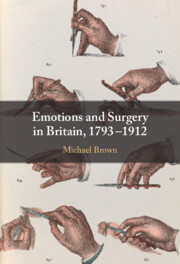Book contents
- Emotions and Surgery in Britain, 1793–1912
- Emotions and Surgery in Britain, 1793–1912
- Copyright page
- Dedication
- Contents
- Figures
- Acknowledgements
- Note on the Text
- Abbreviations
- Introduction
- 1 Between Art and Artifice
- 2 Anxiety and Compassion
- 3 The Patient’s Voice
- 4 ‘Scenes of Cruelty and Blood’
- 5 Quiescent Bodies
- 6 The ‘New World of Surgery’
- Epilogue
- Select Bibliography
- Index
- References
Select Bibliography
Published online by Cambridge University Press: 13 October 2022
- Emotions and Surgery in Britain, 1793–1912
- Emotions and Surgery in Britain, 1793–1912
- Copyright page
- Dedication
- Contents
- Figures
- Acknowledgements
- Note on the Text
- Abbreviations
- Introduction
- 1 Between Art and Artifice
- 2 Anxiety and Compassion
- 3 The Patient’s Voice
- 4 ‘Scenes of Cruelty and Blood’
- 5 Quiescent Bodies
- 6 The ‘New World of Surgery’
- Epilogue
- Select Bibliography
- Index
- References
Summary
- Type
- Chapter
- Information
- Emotions and Surgery in Britain, 1793–1912 , pp. 288 - 301Publisher: Cambridge University PressPrint publication year: 2022
- Creative Commons
- This content is Open Access and distributed under the terms of the Creative Commons Attribution licence CC-BY-NC-ND 4.0 https://creativecommons.org/cclicenses/



